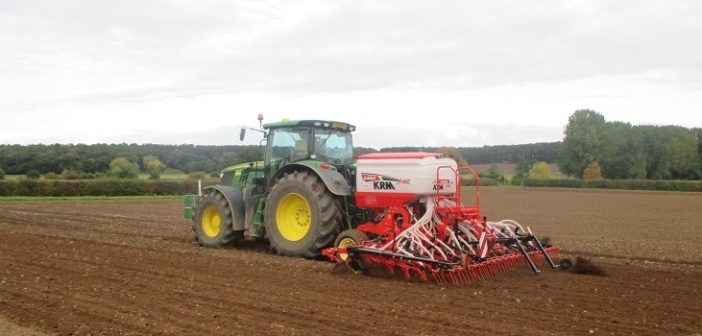There is a lot of discussion over what type of drill is best, with every farmer recognising what an important part they play in getting a good crop established. Given the tricky drilling conditions this autumn, visitors to the Midlands Machinery Show on 20-21 November may find it useful to compare the options face to face with machinery experts.
The first decision is whether to opt for conventional tillage, min-till, no-till or strip-till. There are a lot of benefits associated with no-till, including building organic matter and improving soil structure, and there will be plenty of options to see at the show.
James Dale from Dale Drills will be showcasing the Eco M no-till drill, which comes in widths from three to eight metres. “The drill has individual depth control on each drilling assembly ensuring even seed depth and crop emergence,” says Mr Dale.
Although it is a no-till drill, it can be adjusted to work as a conventional or min-till drill, and it can suit a smaller tractor. “It’s easy to pull with a 120 to 150 horsepower tractor, which means a saving in fuel – and there is less weight on the ground,” he explains. “This drill is good for wetter seedbeds, like we have been experiencing this autumn.”
When considering going to a no-till system, it’s best to phase it in, rather than switching straight over, says Mr Dale. “You need to reduce the tillage over time; the soil structure has to build up over four to six years.”
Among the conventional options to consider will be Lemken’s mounted three metre Zirkon 12 with a Soltair 9 combination drill. “The combination drill, along with the plough, is seeing a revival this autumn due to current weather conditions,” says Craig Brown, area sales manager at Lemken.
“It has always been the farmer’s back-up machine in the back of the shed but over past few years they have proved invaluable, with later drilling windows for blackgrass control. They offer the ability to drill straight after the plough or in wetter ground conditions when trailed drills are unable to travel,” he adds.
For those thinking of strip tilling, Claydon is bringing a four metre Hybrid T4 trailed drill, boasting a reduced cost of establishing crops as well as improved soil condition and reduced erosion. “Instead of using 150-180 litres of fuel/ha to establish a crop using a plough-based system, Opti-Till uses 10-15 litres/ha (average 12 litres/ha), which includes stubble management and drilling,” says Jeff Claydon, CEO of Claydon Drills.
But why should farmers consider strip-till? “Our view is that using no-till alone poses significant risk – particularly on heavier soils – as you are much more at the mercy of wet seasons or dry seasons and may struggle to get seed in the ground.”
The Hybrid drill sows directly into the stubble, with benefits to the soil structure, drainage and undisturbed worm burrows. “Working in tune with Mother Nature rather than trying to dictate to her is essential,” says Mr Claydon. “This includes the use of a good rotation to help control weeds and good timing of operations to allow crops to develop to best advantage in healthy soils that are in excellent condition.”
But is every farm suitable? “Yes – providing that the soil is well-drained, is reasonably sound and work is done when conditions are suitable.”
Mzuri will also be showcasing a single pass strip-till drill – the Pro-Til 3T with a dual tank for fertiliser and seed. “Our trial farm originally came from a max till system, but what was important to us was to achieve consistent establishment without ruining our soils,” says Ben Knight, knowledge exchange manager and trial farmer at Mzuri.
One benefit of this type of drill is the independent coulters, which ensures easy adjustment and constant seed depth control. “We have people using these drills on everything from sand to heavy clay. It copes well drilling into high residue cover crops and allows the soil to restructure whilst benefitting the soils earth worms and eco-system. “It might not be the first drill out in the season but our focus is soil health and making sure the seed goes into a fantastic environment for quick and even establishment.”




